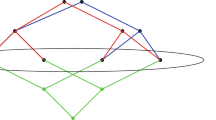Abstract.
In a graph G, the distance from an edge e to a set F⊆E(G) is the vertex distance from e to F in the line graph L(G). For a decomposition of E(G) into k sets, the distance vector of e is the k-tuple of distances from e to these sets. The decomposition dimension dec(G) of G is the smallest k such that G has a decomposition into k sets so that the distance vectors of the edges are distinct. For the complete graph K n and the k-dimensional hypercube Q k , we prove that (2−o(1))lgn≤dec(K n )≤(3.2+o(1))lgn and k/lgk≤ dec(Q k )≤ (3.17+o(1))k/lgk. The upper bounds use probabilistic methods directly or indirectly. We also prove that random graphs with edge probability p such that p n 1−ɛ→∞ for some positive constant ɛ have decomposition dimension Θ(lnn) with high probability.
Similar content being viewed by others
Author information
Authors and Affiliations
Corresponding author
Additional information
Acknowledgments. The authors thank Noga Alon for clarifying and strengthening the results in Sections 3 and 4. Thanks also go to a referee for repeated careful readings and suggestions.
AMS classifications: 05C12, 05C35, 05D05, 05D40
Rights and permissions
About this article
Cite this article
Hagita, M., Kündgen, A. & West, D. Probabilistic Methods for Decomposition Dimension of Graphs. Graphs and Combinatorics 19, 493–503 (2003). https://doi.org/10.1007/s00373-003-0526-z
Received:
Issue Date:
DOI: https://doi.org/10.1007/s00373-003-0526-z




